
 |
State and Regional EconomicDevelopments in CaliforniaPart II |
Background. As indicated previously, Southern California is the largest economic region of the state, accounting for well over one-half of California's total population and workforce. Figure 9 (see page 12) provides a variety of economic and demographic information relating to the Southern California Economic Region. Los Angeles is, by far, the largest county in the region, accounting for 9.6 million in population. It is followed in size by the Orange County, San Diego County, and Riverside/San Bernardino County metropolitan areas (each containing between 2.7 million and 3.1 million people), along with Ventura County (which has a population of about 730,000).
Southern California Economic Region--Selected
Characteristics
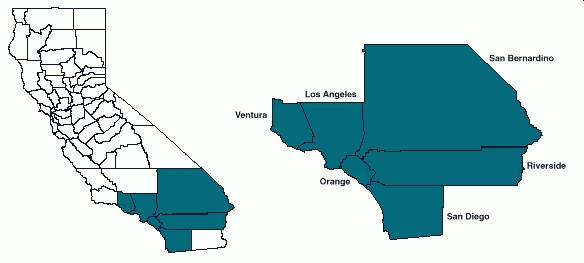
| Key Demographic and Economic Data | |||||
| County | Population | 1996 Per Capita Personal Income | Unemployment Rate June 1998 | ||
| 7/1/90 | 1/1/98 | Percent Change | |||
| Los Angeles | 8,902,000 | 9,603,300 | 7.9% | $24,945 | 6.3% |
| Orange | 2,417,600 | 2,722,300 | 12.6 | 28,936 | 3.0 |
| Riverside/ San Bernardino | 2,631,300 | 3,063,100 | 16.4 | 19,090 | 6.1 |
| San Diego | 2,511,400 | 2,794,800 | 11.3 | 24,282 | 3.5 |
| Ventura | 670,200 | 730,800 | 9.0 | 25,839 | 4.9 |
| Recent Employment Trends | ||||||
| County | Nonfarm Employment 1st Half 1998 | Percent Change | ||||
| 1994 | 1995 | 1996 | 1997 | 1998 | ||
| Los Angeles | 3,948,483 | -0.8% | 1.3% | 0.8% | 2.1% | 2.8% |
| Orange | 1,266,650 | 0.4 | 2.3 | 2.9 | 3.2 | 4.3 |
| Riverside/ San Bernardino | 874,017 | 1.2 | 4.4 | 3.1 | 4.6 | 4.6 |
| San Diego | 1,072,667 | 0.6 | 1.9 | 3.0 | 4.1 | 3.3 |
| Ventura | 248,850 | 1.9 | 2.5 | 0.3 | 1.8 | 3.0 |
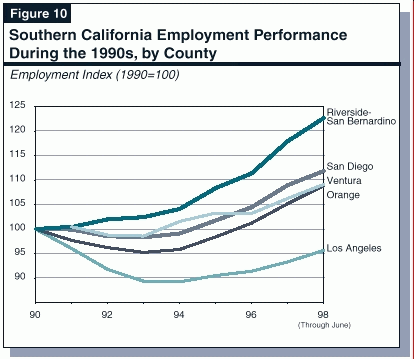
In addition to being the state's single largest county-level economic area, Los Angeles County has been through the most extensive and difficult economics-related transition of any region in California. The striking impact of this transition on employment in selected industries over the past decade is depicted in Figure 11 (see page 16). The single largest and most dramatic change has been a major reduction in the number of durable goods manufacturing jobs. This sector has fallen by more than 170,000 jobs since 1990, including over 100,000 aerospace jobs. The county also lost large numbers of jobs in the wholesale trade, retail trade, finance, and construction industries.
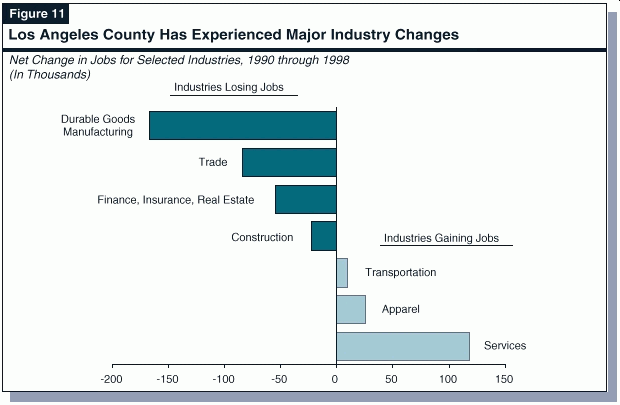
These losses have been partly offset by gains in service-related jobs, particularly in motion picture production and business services. The county also has gained approximately 30,000 jobs in the apparel industry over the past eight years. This is in striking contrast to the nation as a whole, which has experienced job losses in this industry. Finally, Los Angeles County has gained a significant number of jobs in transportation and warehousing industries, reflecting the major expansion of international trade flows through the Ports of Los Angeles and Long Beach during recent years.
Film Industry Strong Through Mid-Decade. One of the few sources of economic growth in Los Angeles during the early and mid-1990s was the film production industry. This high paying industry includes a variety of activities associated with the production and distribution of movies and television-related products. As shown in Figure 12 (see page 16), motion picture production employment increased from slightly below 90,000 jobs in early 1992 to nearly 140,000 jobs by early 1997an annual average growth rate of about 10 percent. Gains in this industry also had ripple effects on other parts of the area's economy, leading to job growth in apparel design, advertising, and related service industries in Los Angeles County.
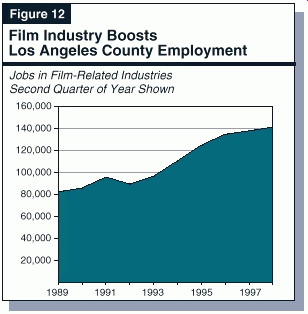
Regional Effects of Defense CutbacksDefense cutbacks have taken a major toll on California, which has historically received one out of every five dollars spent by the U.S. Department of Defense. At the end of the cold war in the late 1980s, military spending in California totaled more than $50 billion, or about 8 percent of California's Gross State Product. About three-fourths of total defense outlays in the state involved contract spending--mostly directed to private defense aerospace firms--for the research, development, and production of major weapons systems. The remaining one-fourth of outlays was related to military and civilian personnel working on military installations throughout the state. The defense cutbacks which occurred affected both of these areas of contract spending and personnel. As described below, the primary impact of the cutback in contract spending has been in the southern portion of California, while the impact of base closures and consolidations was centered in the northern half of the state. Contract Spending Cutbacks. The decline in defense contract spending, coupled with the consolidation of major defense companies to locations outside of California, has caused statewide employment in the aerospace industry to decline from 370,000 in 1988 to slightly more than 160,000 in 1996. Despite some modest gains since 1996, aerospace employment remains below 170,000, less than one-half the level of a decade ago. As shown in the first accompanying figure, the majority of the job losses--fourth-fifths
of the total--have occurred in Southern California, and nearly two-thirds
have taken place in Los Angeles County alone. The aerospace job losses
are especially significant because they are generally high paying jobs.
For example, the average salary for aerospace industries in 1997 was $57,000.
This compares to the statewide average salary for all industries of about
$32,000 during the year.
Base Closures. Over the past decade, Congress has approved the closure and realignment of numerous military bases across the country. Actions taken so far have resulted in the closure of 25 bases in California. Along with these reductions have come the realignment of 57,000 military personnel and the loss of over 42,000 civilian jobs in the state. The second accompany figure shows the distribution of civilian job losses in California. It shows that the majority of the losses are in the northern and central regions of California, reflecting the closure of such major installations as McClellan Air Force Base and Castle Air Force Base in the Central Valley, the Naval Air Station of Alameda, Mare Island Naval Ship Yard, and Fort Ord Army Base. Many military bases in Southern California have been closed or downsized, including George, Norton, and March Air Force Bases in Riverside and San Bernardino Counties, and the Long Beach Naval Ship Yard. However, San Diego County actually gained military and civilian personnel as the result of the closure and consolidation process, as many naval operations were moved to San Diego from other locations on the West Coast of the United States. Overall Impact of Defense Cuts. Given relatively larger size of the contract spending cutbacks and the number of employees involved, the majority of the overall impact of defense cutbacks has been in Southern California and, in particular, Los Angeles County.
|
However, Film Industry Has Slowed. After several strong years, job growth in this industry slowed during the latter half of 1997, reflecting a cutback in film production by major studios. Factors responsible for the slowdown include slowing foreign demand for films and rising production costs, which together are squeezing earnings and leading to fewer major productions. While these factors are being partly offset by strong growth in satellite and cable television markets, it appears that near-term growth in the film industry will remain moderate compared to recent years. Nevertheless, motion picture, television, and other film-related production will remain an important economic force in the Los Angeles County economy.
Overall Economy Currently Growing at Moderate Pace. Employment in Los Angeles County increased by 2.8 percent between the first half of 1997 and the first half of 1998, reflecting broad-based growth in services, trade, manufacturing, and construction activity. Although still below the statewide average, the annual increase is the largest in a decade.
In other signs of renewed economic strength, real estate prices and sales are up sharply in the county, and new construction of nonresidential facilities--including offices, industrial building, and retail stores--has jumped 40 percent during the past year. Finally, major capital expansions associated with the Los Angeles and Long Beach Port facilities should boost employment and income in the area's economy. While the region faces some job losses associated with further planned cutbacks by Boeing, Northrop, and other aerospace companies, the overall outlook for the region remains positive.
The Riverside/San Bernardino metropolitan area (generally referred to as the Inland Empire) is the most populous metropolitan area in California, following Los Angeles County.
The Inland Empire experienced major increases in population and jobs in the 1980s, reflecting the migration of people seeking affordable housing from the higher-cost coastal regions of Southern California. (Home prices in the Inland Empire, for example, have been considerably lower than for its neighboring coastal counties in Southern California.) Many of these interregional migrants continue to maintain jobs in Los Angeles and Orange Counties, and thus face long commutes. The Inland Empire was the center of California's construction boom in the second half of the 1980s, accounting for as much as one-fifth of the volume of statewide residential construction activity in the latter part of the decade.
Partly because of its dependence on population growth for its economic expansion, the Inland Empire was hard hit when migration into the region slowed with the early-1990s' recession. Although the Inland Empire avoided the major economic downturns of its coastal neighbors, the early 1990s were characterized by high unemployment rates, numerous home loan defaults, and declining property values in the region. The closures of Norton and George Air Force Bases also adversely affected the Inland Empire during this period.
Economy Is Developing Its Own Industrial Base. In more recent years, the Inland Empire has experienced renewed growth, with employment increases
averaging about 4 percent annually during the past three years. This growth has been somewhat more subdued than experienced in the 1980s, but it also has
been considerably more balanced than in the past. While the area's recent economic gains have partly been related to improving construction activity, there also
has been significant percentage job growth in transportation, warehousing, manufacturing, services, and trade-related industries (see Figure 13 on page 18).
Many jobs in the latter industries are related to the shipping and distribution of internationally traded goods flowing through the Ports of Los Angeles and Long
Beach.
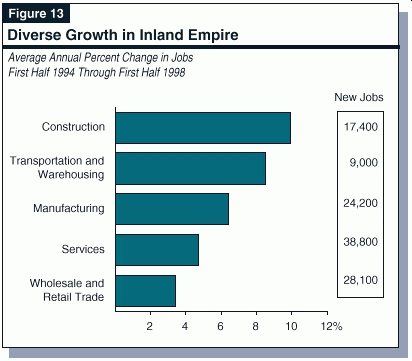
The growth in these diverse industries is a positive development for the Inland Empire region, for two reasons. First, more of the people in the region are finding jobs locally and thus are avoiding the lengthy commutes into Los Angeles and Orange Counties. Second, the diversification means that the region's prospects for continued prosperity in the future are less tied to continued strong in-migration of people from elsewhere.
Real Estate Activity Finally on Rebound. After remaining depressed for several years, real estate markets are finally rebounding in the Inland Empire. Home sales, prices, and construction activity are climbing in 1998, and major builders are returning to the region. The region is also experiencing large increases in nonresidential construction, particularly involving industrial and commercial buildings.
Continued industry growth and diversification, coupled with a rebound in the region's real estate markets, will likely result in continued economic expansion in this region during the next several years.
Orange is the fourth largest metropolitan area in Southern California, with 1.3 million jobs and 2.7 million in population as of early 1998. The county is characterized by high incomes and housing prices, and very low rates of unemployment. Orange County has a large computer and electronics industry, trailing only Silicon Valley and Los Angeles. It has a large number of workers in aerospace firms involved in the production of advanced missiles, satellites, and navigation systems. A large number of workers in the region are also employed by firms in high-paying service industries, including computer services, engineering, and management consulting. Finally, as home to Disneyland and several other attractions, Orange County is a major tourist destination.
Region Was Hard Hit by Statewide Slump. Orange County was California's third fastest growing metropolitan region in the 1980s (behind Riverside/San Bernardino and San Diego). As with the rest of Southern California, however, the region was hard hit by the defense cutbacks and real estate slumps that took place in the early 1990s. The county lost nearly 5 percent of its job base between 1990 and 1993, the second largest percentage decline in a major subregion behind that experienced in Los Angeles County.
Area's Economy Among Strongest in State During Past Year. Orange County began to emerge from the 1990s' recession along with the rest of the state in late 1993. During the subsequent three years, however, the area's job and income growth was somewhat subdued by historical standards for a recovery period, and slower than for many other parts of the state. This changed dramatically during 1997 and early 1998. Between the first half of 1997 and the first half of 1998, the county added 52,000 jobs, a 4.3 percent increase. The growth was led by gains in such industry subsectors as high technology manufacturing, business services, communications, wholesale trade, and construction. The job gains have pushed the unemployment rate in Orange County down to 3 percent as of June 1998.
In other signs of economic strength, the county's real estate markets have rebounded sharply during the past two years. Home sales, home prices, and new
residential construction have been climbing. Nonresidential
construction activity is also up sharply, reflecting major increases associated with the construction of industrial and office buildings.
Overall, Orange County is among the fastest growing regions in the state in mid-1998, and all signs point toward continued growth during 1999 and beyond.
San Diego is the state's third largest MSA, accounting for 2.8 million in population and 1.1 million in wage and salary jobs as of early 1998. Although in earlier
decades the county was primarily known for its military-related complexes, San Diego's economy has undergone major changes during the 1990s. Thee impact
of these changes on key job categories is shown in Figure 14.
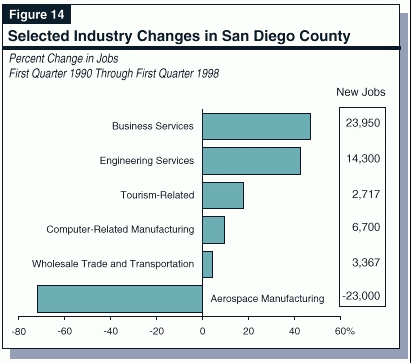
Major Declines in Aerospace Activity Have Taken Place. In percentage terms, no other region was harder hit than San Diego by the aerospace cutbacks in the early 1990s. Between 1990 and 1995, San Diego lost most of its major aerospace employers through industrial takeovers and consolidations. As a result, employment in the aerospace subsector dropped from 31,000 in 1988 to about 9,000 in 1998. The declines in this key industry in the mid-1990s depressed job and income growth during the early stages of the statewide economic recovery.
At the same time, the region has seen significant increases in several other major industries. Figure 14 shows that these include the business services, engineering services, and computer-related manufacturing industries. The figure also shows that San Diego has experienced job increases in wholesale trade and transportation industries--which are related to expanded trade with Mexico--as well as in tourism related industries.
Economy Currently Strong. The 1990s' economic expansion began somewhat unevenly in San Diego. Due in part to the persistent job losses in aerospace
industries, the county faced concerns that many of the new jobs being created were of lower pay and benefits than those lost during the aerospace cutbacks.
However, the area's economy gained momentum in 1997, with many industries posting job gains--including a variety of high paying sectors such as
engineering, software development, health care technology, and biotechnology. The county is also experiencing a major
resurgence in building activity. The gains in both residential and nonresidential construction activity in 1998 are among the largest in the state. These current
positive trends appear likely to continue through the end of the decade.
Ventura has a varied economic base, including some defense and high technology businesses. The county was one of the fastest growing regions of the state in terms of population during the 1970s and early 1980s, and its economic performance reflected this in terms of gains in jobs and income. Ventura's economic growth rate in the 1990s, however, has been fairly modest.
Ventura experienced a moderate downturn in the early 1990s, primarily relating to losses in defense and construction employment. Its economy grew at a slow and uneven pace in the early stages of the state's post-recession recovery and subsequent expansion, but has accelerated during the past year. Industries contributing to this strengthening include durable goods manufacturing, trade, services, and construction. The unemployment rate in the county stands at 4.9 percent, somewhat below the statewide average.
Return to Regional Economics Part I